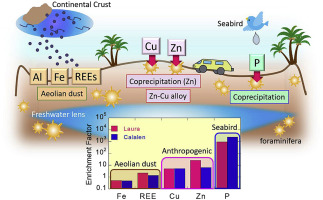Chemosphere ( IF 8.1 ) Pub Date : 2018-03-13 , DOI: 10.1016/j.chemosphere.2018.03.083 Lisa Ito , Takayuki Omori , Minoru Yoneda , Toru Yamaguchi , Ryuta Kobayashi , Yoshio Takahashi

|
The sediments of Majuro Atoll, Marshall Islands, consist of bioclastic materials, including foraminifera and coral debris. The sedimentary depth profiles of elements showed that various elements including zinc (Zn) and copper (Cu) were enriched in the upper layers of the islands of Majuro Atoll. Carbon-14 dating revealed that the sedimentation of the upper layer was completed before 1670 and 542 cal BP in Laura and Calalen, respectively. The enriched elements could be categorized by their origins: (a) terrestrial elements transported as dust (aluminum (Al) and rare earth elements (REEs)); (b) anthropogenic elements (Zn and Cu); and (c) elements supplied by seabirds (phosphorus (P)). From the results of the total amount of Al supplied to sediments for ca. 2000 years, Al in Majuro Atoll was suggested to be airborne origin. The enrichment factors of the elements normalized to Al concentration of continental crust showed that REEs were also transported as dust, while Zn and Cu were mainly of anthropogenic origin. The speciation analysis by X-ray absorption near-edge structure (XANES) showed the presence of Zn–Cu alloys originated from industrial products. It was also revealed that Zn was enriched in the surface due to anthropogenic emission after urbanization on Majuro Atoll and fixed by carbonate and phosphate at the upper layer, which inhibits migration of Zn into the deeper layer and its release to the groundwater and costal water. Hence, the fixation of heavy metals at the surface prevents their exposure to aquatic organisms and residents via fresh groundwater in the island.
中文翻译:

马绍尔群岛马朱罗环礁表面沉积物中微量元素的起源和迁移
马绍尔群岛马朱罗环礁的沉积物由生物碎屑物质组成,包括有孔虫和珊瑚残骸。元素的沉积深度剖面表明,Majuro环礁岛的上层富含锌(Zn)和铜(Cu)等各种元素。碳14测年表明,上层的沉积分别在劳拉和卡拉伦分别在1670和542 cal BP之前完成。富集元素可以按其来源分类:(a)以尘埃形式运输的陆地元素(铝(Al)和稀土元素(REEs));(b)人为元素(锌和铜);(c)海鸟提供的元素(磷(P))。从提供给沉积物的总铝量的结果来看,大约为 2000年,有人认为马朱罗环礁的铝是机载飞机。归因于地壳铝浓度归一化的元素的富集因子表明,稀土元素也以粉尘形式运输,而锌和铜主要来自人为来源。通过X射线吸收近边缘结构(XANES)进行的形态分析表明,存在源自工业产品的Zn-Cu合金。还揭示出由于城市化后马朱罗环礁上的人为排放而使锌在表面富集,并被上层的碳酸盐和磷酸盐固定,这抑制了锌向更深层的迁移以及向地下水和沿海水的释放。因此,重金属在地表的固定可防止其通过岛上的新鲜地下水暴露于水生生物和居民。











































 京公网安备 11010802027423号
京公网安备 11010802027423号